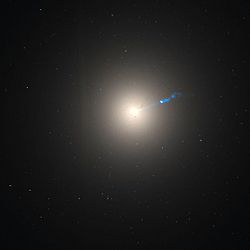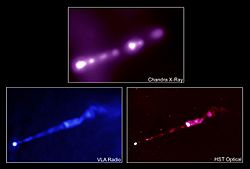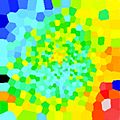Messier 87 facts for kids
Messier 87 (also known as M87, Virgo A or NGC 4486) is a supergiant elliptical galaxy. It was discovered in 1781 by the French astronomer Charles Messier, who catalogued it as a nebulous feature. The second brightest galaxy within the northern Virgo Cluster, it is about 16.4 million parsecs (53.5 million light-years) from Earth.
Unlike a disk-shaped spiral galaxy, Messier 87 has no distinctive dust lanes. It has an almost featureless, ellipsoidal shape. Luminosity diminishes with distance from the centre. At the core of this unusually large galaxy is an unusually large supermassive black hole. This is a strong source of radiation at many wavelengths, particularly radio waves. This black hole is the first and, to date, the only one for which astronomers have been able to make a direct image. A radio image taken by the Event Horizon Telescope in 2017 was published on 10 April 2019. The image shows the shadow of the black hole, surrounded by an emission ring with a diameter of 3.36×10−3 parsecs (0.0110 light-years).
A jet of energetic plasma known as a blazar is thrown out by the black hole at near the speed of light. It goes outward at least 1,500 parsecs (5,000 light-years). In pictures taken by the Hubble Space Telescope in 1999, the motion of Messier 87's jet was measured at four to six times the speed of light. This motion is probably an optical illusion caused by the relativistic velocity of the jet.
Stars
The stars in this galaxy form about one sixth of Messier 87's mass. They are spread out symmetrically, but the density of stars decreases with distance from the core. The galactic envelope extends out to a radius of about 150 kpc (490 kly), where it stops—possibly cut off by an encounter with another galaxy. Between the stars is a diffuse interstellar medium of gas that has been chemically enriched by elements emitted from evolved stars.
Orbiting the galaxy is a huge number of about 12,000 globular clusters, compared to 150–200 globular clusters orbiting the Milky Way.
Messier 87 is one of the most massive giant elliptical galaxies near Earth, and one of the brightest radio sources in the sky, It is a popular target for both amateur and professional astronomy study.
Images for kids
-
Composite image showing how the M87 system looked, across the entire electromagnetic spectrum, during the Event Horizon Telescope's April 2017 campaign to take the first image of a black hole. Requiring 19 different facilities on the Earth and in space, this image reveals the enormous scales spanned by the black hole and its forward-pointing jet. The upper left of the figure is an image taken by ALMA, showing the larger-scale jet observed on the same scale as the visible image taken by the Hubble Space Telescope and the X-ray image by Chandra (upper right).
See also
 In Spanish: Galaxia elíptica M87 para niños
In Spanish: Galaxia elíptica M87 para niños







